Roses: Simple Tips & Advice
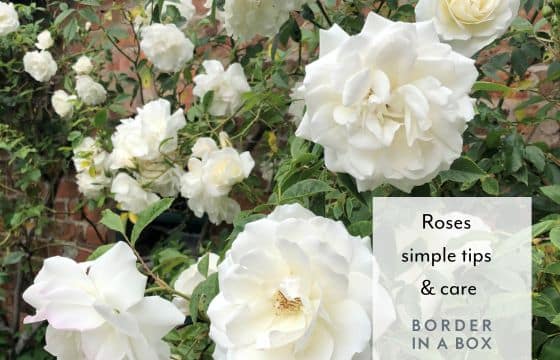
Roses: simple tips on how to take care of them for beautiful blooms
Roses are the staple of a traditional English garden and are relatively simple to take care of. Firstly, you need to choose the right plant for the right spot. Most prefer to be in a sunny site in moisture retentive soil, but always add some well-rotted manure when planting. Keep them well watered too whilst they get established, especially during the first year.
Roses, especially the repeat flowering varieties need a regular supply of nutrients throughout the growing season, but don’t over feed! There are plenty of available products to choose from, so just follow the instructions on the packaging.
There are varieties of roses available that have been bred to reduce the amount of pests and diseases – which I would recommend you buy as this will reduce the amount of maintenance required. If you have yellow or spotted leaves, remove them by hand and put in the bin (not in the compost bin), remove any fallen leaves from the ground, as this will spread the diseased spores too. Aphids can be removed my hand and then given a spray of soapy water. Do this as soon as you spot them to keep your roses healthy.
Remember to dead-head fading flowers to encourage new blooms, unless it is a single flowering rose, in which case leave them to form the hips for feeding the birds during the winter months.
When looking for roses at the garden centre you may see various types of roses available, which the labels may cause confusion or overwhelm, so here’s the most likely type of roses you will see:
Types of roses:
Tea roses
Hybrid Tea Roses have pointed ‘bud flowers’. Each stem usually holds a single flower with sparse foliage at the base – think of Valentines day roses. Hybrid Teas have a range of colours from pastels to vibrant shades. They have a short, upright habit and are excellent for rose beds, formal rose gardens and even narrow borders.
At the 2024 Plant of the Year, this variety Rosa Chelsea Pensioner was launched by Harkness Roses. This particular rose has spicy-perfumed bright red blooms, Lush foliage, strong growth and a bushy habit. Easy to grow and flowers from June to October.

This variety is called ‘Nostalgia’ which is growing in our garden…
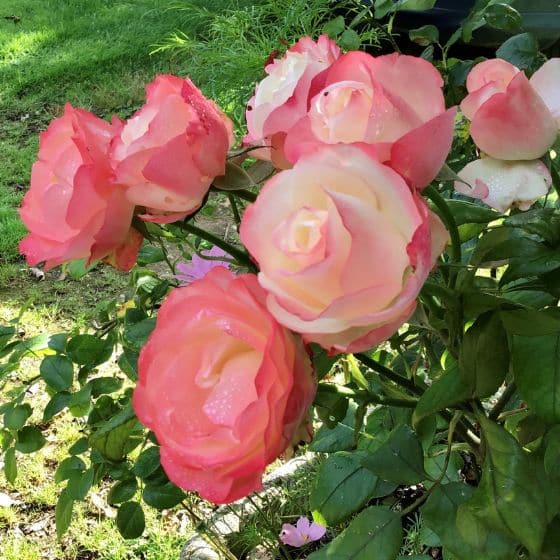
Floribunda
Floribunda roses were originally produced by crossing Hybrid Teas with Polyantha Roses. They produce flowers in large clusters over a long season and traditionally have less scent, although new fragrant varieties are now available. They are ideal for most gardens as they are generally hardy, robust and more disease resistant than Hybrid Tea Roses which makes them easier to grow.
This variety is called ‘Hot Chocolate’
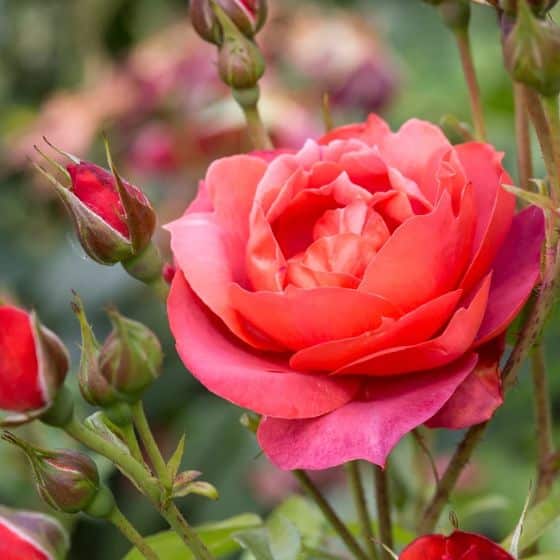
Shrub rose / English rose
(Definition of a shrub: a woody plant which is smaller than a tree and has several main stems arising at or near the ground.)
English Roses have a shrub-like bushy, upright growth and their height can vary from being quite short to tall. Compact English Roses work well in rose beds, whilst taller varieties can be trained against a post and rail fence. Most varieties will be happy in part shade which is four or five hours of good sun a day.
This variety is called ‘Lady of Shallot’
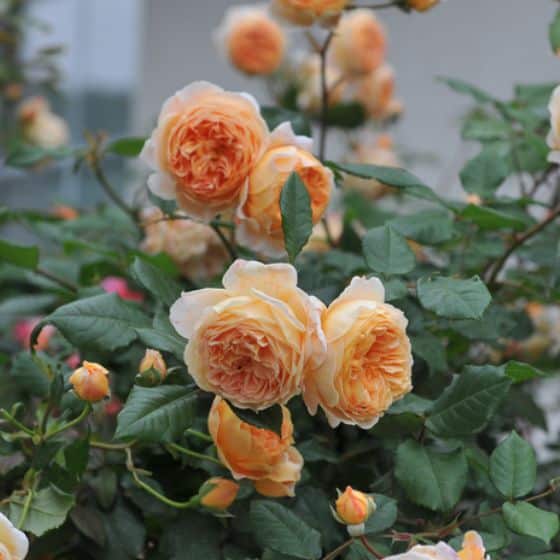
You may come across other types of roses, such as patio roses – these have been bred specifically for container gardens, so are usually smaller in size and flowers. Also climbing roses – the difference between a climbing rose and a rambling rose is mainly the flowering periods.
Rambling roses are much more vigorous than climbers, usually providing a single, magnificent flush of smaller flowers in June and July. To get more flowers buy a repeat-flowering rambler. They flower on the previous year’s growth, so need pruning straight after flowering, with the old stems being cut right back. Many are fragrant and they’re great for covering pergolas, arbours and arches.
This is a rambling rose in Mum’s garden – it’s a beauty! It’s been growing for many years and we don’t know the variety.

How to prune a rose
There are many books written on the subject of pruning, but here are some simple tips to keep your rose(s) healthy and happy:
The best time to prune a rose is around February/March. Roses need to be pruned to keep them in shape as they can get very bushy and leggy if left alone. It is also good to cut out old dying stems as this will also encourage fresh new growth which means better and more flowers.
- Regardless of how old your rose is you will need to remove any dead, dying, diseased or damaged stems.
- Always use sharp and clean secateurs as this ensures the cuts are less likely to become diseased.
- Cuts should be close to, but above a bud and should slope away from it, so that water does not collect on the bud.
- It’s best to feed roses twice a year:
- Late-March/April at the beginning of the growing season.
- Late July after the first bloom cycle has finished, promoting stronger repeat flowering.
- Use organic matter or feed created specifically for roses to get the correct amount of nutrients they need.
Year 1
You may not need to prune during the first year as the rose is becoming established, however it may need a bit of shaping and general TLC.
Year 2
As the rose is starting to mature, cut back all stems by one third. Cut back any particularly long stems to the same length as the rest of your shrub.
Year 3
Your rose should be well established by now, so before pruning, choose from one of the following:
- For a taller shrub – cut back by less than one third.
- To maintain its current size – cut your rose back by one third.
- To reduce its size – cut back by a half or even more. This will reduce the size of the shrub without impacting the amount of flowering.
If you’re wondering how to prune, here’s a fabulous diagram that I found on the internet – unfortunately I couldn’t find the originator to link to them. It shows dead and crossing branches. The types of pruning – hard, moderate and light. Plus the direction of the cut and where abouts on the stem to cut.
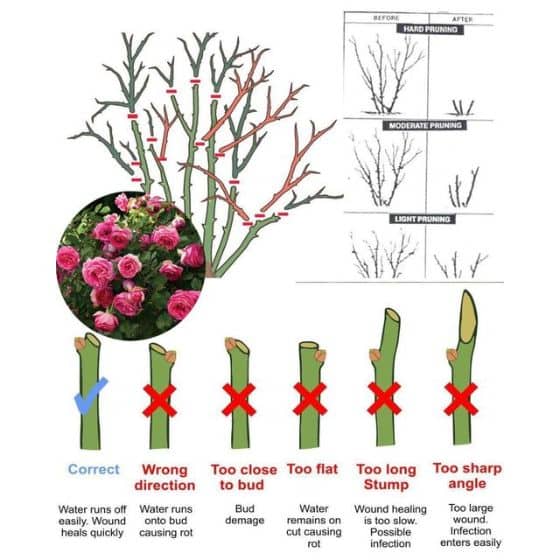
How much water and when?
As a guide, David Austin Roses recommend watering the following amount per rose each time you water:
- Shrub roses – 5 litres
- Climbing roses – 10 litres
- Rambling roses – 10 litres
- Standard tree roses – 10 litres
- Roses in pots – 5 litres
October to February – unlikely to need any water in the UK
March to May – if there’s a dry spell of two weeks or more: Newly planted roses – water every two or three days. Established roses – water once a week.
June to September – Newly planted roses – water every other day. Established roses – water once a week. However, if your flowers start wilting, this is a sign your roses need more water (especially if it’s in a container with peat free compost).
General Care:
- Remove any weeds and debris from underneath the rose – this helps maintain good plant health. Remove any diseased leaves and put them in the bin – don’t compost them as they may contain a fungal disease that could spread.
- Aphids – if the ladybirds haven’t munched on them, the best thing to do is wipe off the aphids (I use my hands), then use a squirty bottle with some washing-up liquid and water (aphids don’t like soap!). I repeat this over several days to ensure all the aphids have gone. Make sure you do this as soon as you see aphids as they multiply at an alarming rate!

If you would like ideas on what to plant with your roses, The Scented Garden Design Kit includes a ready-made planting plan suitable for any sunny or part sunny garden with normal soil.

Here’s the link for more information – Scented Planting Plan
 Free Delivery
Free Delivery Upgrade to 24 Hour Tracked Delivery
Upgrade to 24 Hour Tracked Delivery

